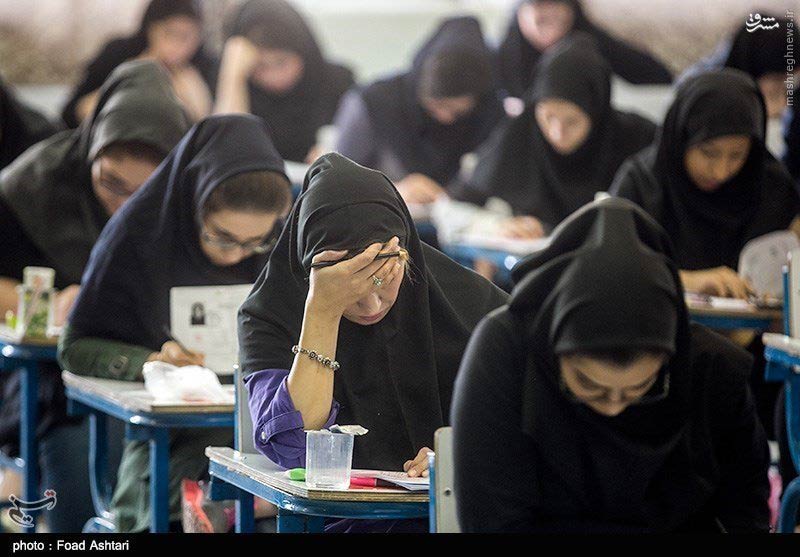by Shervin Malekzadeh
The unfolding university admissions scandal here in the United States has been an education in American exceptionalism. That the standard of entry to higher education might include the ability to play squash or ride a show horse proves difficult to explain to much of the rest of the world, where high-stakes standardized testing reigns as the sole gatekeeper to college, invested with absolute authority to sort populations based on merit and academic “ability.”
The shenanigans of Felicity Huffman and Lori Loughlin, aka Aunt Becky, compare unfavorably to the case of Iran, where the ordeal of the konkur—a four-and-half-hour, all-or-nothing entrance exam administered once a year across the entire country—serves as an effective if uneven barrier to corruption. In a country where access and influence remain open to purchase or violent persuasion, college admission represents one of the very few mechanisms outside the reach of moneyed influence, prestige, or parti bazi. Iranian families resent the tyranny of the konkur for the stress and anguish that it brings to their homes. They hate the idea of getting rid of it even more.
Introduced under the shah during the late 1960s, the konkur ranks prospective students on their performance across one of six subject areas; the higher the rank, the greater the chance candidate will able to attend the university and department of her choice. An entire year of preparation goes into the exam—10 to 12-hour days are not uncommon—which distill into a single day of testing in late June. The konkur occupies a quasi-sacred date on the national calendar, and all efforts are made to preserve the process as transparent and aboveboard. Test administrators treat questions as state secrets, and key members of the design team enter into quarantine in the days leading up to the test so as to reduce, if not eliminate, the possibility of cheating.
Like all standardized tests, the konkur provides a narrow and biased measure of ability, based on the fiction that this single test offers an objective forecast of future potential, regardless of economic circumstance or access to social capital, or the various ad hoc factors that might plague students on test day, be it sickness or nervousness. Nonetheless, for many Iranians the konkur stands out as a best case if imperfect scenario for improvement in a country otherwise stratified by the unearned distinction of family name and wealth. If modern, merit-based education is billed as the solution to social inequality, then in Iran the konkur acts as the fulcrum that lifts deserving populations to a better life.
Learning to Fail
Failure, however, has been the standard experience for most. During the first three decades of the konkur’s existence, acceptance rates rarely surpassed 10 percent, despite explosive growth in the student population. Some 70,000 applicants sat for the test during the 1969-1970 school year. Less than ten years later, in 1978 and with the country on the verge of revolution, the total number had ballooned to nearly 300,000. Just short of 30,000 passed.
Little changed after the revolution. Children born during Iran’s population boom in the late 1970s and early 1980s faced particularly grim odds. Of the over 750,000 individuals who took the konkur in 1989, only 54,590 gained entry, a paltry rate of 7 percent. In 1999, at the far edge of Iran’s demographic wave, an astounding 1.34 million sat for the test. Only 145,000 managed to get through.
Az konkur oftadam (“I fell from the konkur”). Posht e konkur moondam (“I was stuck behind the konkur”). A vernacular of disappointment binds generations of test takers together around the shared experience of futility. Although private universities have made up some of the difference, for the vast majority of Iranians higher education remained a dream well out of reach. With the Pahlavi and IRI states unable, or unwilling, to meet demand with capacity, the number of students left behind had become a scandal in its own right by the early 2000s.
Relief came with the arrival of populist Mahmoud Ahmadinejad. Eager to shore up his base, Ahmadinejad fueled the explosion of affordable distance-learning and part-time universities. Many of these new entry points to university education directly benefited the small-town poor who constituted the core of Ahmadinejad’s constituency. The result was a threefold increase in capacity at the university level between 2005 and 2011, from just over 383,000 available spots to 1.1 million. Reforms produced in short order the most educated generation in the country’s history—more than 70 percent of 18- to 24-year-olds are enrolled in some form of higher education, triple the rate from just 10 years ago.
Coercion by Other Means
At the same time, the Ahmadinejad administration was not shy about using access to higher education as a form of crowd control, another stick in the coercive arsenal of his lawless administration. The phenomenon of the “starred student,” in which Iran’s intelligence apparatuses flagged individuals who had passed the university entrance exam as politically unreliable or undesirable, lasted throughout his term in office. Otherwise qualified candidates marked with a single star continued their education on the condition that they would cease their political activities. Those badged with two or more stars were rejected outright, regardless of how well they had performed on the konkur. Although the incoming administration of Hassan Rouhani eliminated this practice in 2013, disturbing reports have lately emerged that it has once again been revived.
Fear and paranoia toward the university student has not been limited to Iran’s current rulers. Acting against the advice of his planners and the evident demand from the public for higher education, the shah prevented the expansion of the country’s university campuses. With capacity sharply restricted, and under the guise of merit, the konkur proved to be an effective and reliable device for keeping out elements the government deemed “subversive,” while rewarding those who had a vested interest in preserving the existing social order. Equipped with resources that facilitated success on the konkur, members of Iran’s higher classes entered into university at rates disproportionate to the rest of the population. For the vast majority of Iranians, the pursuit of education became what David Menashari describes as “a bridge to nowhere.” By the time the shah reversed course in the last decade of his rule, it was already too late.
Denial of access comes at a cost, whether it is done by the monarchy or the followers of Khomeini. Over the years the university degree has become a measure of personal dignity, a benchmark of a life fully lived, and of revolutionary promises fulfilled. The legitimacy of state and government hinges in part on how well it can provision this good to the public. The insatiable demand from the public for higher education, unabated by revolution or war, ensnares both the state and society.
Education was supposed to break the wheel of poverty and injustice in Iran. Instead, schooling set it spinning faster, without a way to stop or exit. Trapped by the terrible logic of merit, students see no end to improvement. As bachelor’s degrees have become ubiquitous—some 40 percent of college-age students in Iran are on track to have a college degree of some sort, comparable to figures in the United States—standards of accreditation have risen accordingly. In Iran, the master’s degree is gradually replacing the BA as the minimum standard for entry into the labor force, and the PhD has become the new MA. To stay ahead of the rising tide, those with means, skills, and connections seek the higher ground of the foreign university. Getting a daughter into the engineering faculty at Amir Kabir is impressive, an accomplishment worthy of praise. Going to Stanford is to win the game outright.
Never-ending Story
The official line out of Tehran is that participation in education is a form of worship: the experience of sending a son or daughter to university is the fulfillment of the revolution’s promise to provide heavenly justice here on earth.
Iran’s authorities have been unable to preserve their paradise from the perils of rank and hierarchy. The meritocracy in Iran, as it does most everywhere, functions as a powerful instrument of class differentiation that, for all of its pretensions of merit and objectivity, favors those with the cultural resources at their disposal to game the examination system of entry. The konkur levels the playing field, but some show up better equipped to play the game than others. The process of admissions has had the effect of amplifying the privilege of those already occupying the commanding heights of Iran’s cultural and material wealth.
Reproduction of unearned and inherited privilege is a bad look for a regime putatively devoted to serving the dispossessed. When I was doing my doctoral fieldwork on post-revolutionary education, my interview subjects described going to university in Iran as being a bit like trying to pass water through a funnel with the thin side up and its mouth turned down to the ground: It is exceedingly difficult for students to get into university (the funnel). But once in, getting out with a degree is almost guaranteed. Passing the konkur was accomplishment enough, a signal that one was qualified for success.
The metaphor’s point of reference was the United States, which my interlocutors perceived as having the admissions funnel reversed with the “correct” side up (the mouth) and the thin part pointing downwards: American students have enormous opportunities for getting into college, but because of the rigor of U.S. academics, few come out with the credential in hand.
The metaphor of a “right-ways” funnel gets it correct when it comes to the United States but for the wrong reasons. Most Americans who wish to attend college can. The vast majority of U.S. college students are studying at community, for-profit, or non-selective institutions (according to the Department of Education. More than three-quarters of U.S. undergraduates attend schools that accept at least half their applicants; well under one percent attend schools that accept less than 10 percent. Most also struggle to complete their degrees, but too often for reasons other than the rigors of academic study. The narrowing of the funnel, as it were, comes as a result of inadequate childcare, the need to attend school part-time while holding down one or more jobs, the predatory lending practices of the unscrupulous more interested in making a quick buck than in educating their charges.
The United States turns out to be much more like Iran than the Iranians give it credit for. For the tiny minority of university students who attend selective schools in this country, the funnel reverses once again. Get into a Swarthmore, a Williams, a Harvard, and you’re set. Whether you do well or perform poorly over your four years, a network awaits you outside the school to reward the hard work of getting in. Such is the power of the school’s label and brand that a mediocre undergraduate career might be enough to someday get a job as a professor.
That these selective institutions, which serve a vanishingly small percentage of the university population in the United States, garner most of the attention in the news and from the public speaks to the biases in U.S. society, as well as the sociology of the newsrooms and reporters who cover higher education. Those who labor around the narrow end of the funnel might want to reflect on how educators enable this particular game of achievement, contributing to the reproduction of the bad practices that make a spot at USC so desirable that a mother would be willing to move heaven and earth to get her daughter in.






I went through it in 1976, 500,000 participant & accepting only 50,000! Not getting through, the capacity of universities were limited so people like me went to America. I am 100% sure all the Politician’s children (Aghazadeha) are ALLOWED in the universities if they can not get to Western countries. Privilege exist everywhere but that tells you something about level of education in US vs most of the world. Nightmare of Konkur I will never forget..
I fully agree with (and share) Piere’s view and experience. Thanks to Dr. Malekzadeh for this wonderful essay, I only wonder the reason he (purposefully) omitted mentioning even the iconic name of Iran’s former President, the late Ayatollah Hashemi Rafsanjani (possibly killed two years ago, by drowning, at the hands of the hard-core “followers” of Khamenei, the “Supreme Leader” in the “hidden state” intelligence service of the revolutionary guards), who was HATED by the clinically narcissist vulgarly populist (like Trump) “President” Mahmoud Ahmadinejad, in part because it was Hashemi who had brought (at least) partial relief from the nightmare of Konkur, by founding (in late 1980s, I think) the Azad (Independent) University system — the capacity of which expanded greatly the number of (mainly middle class) university students in Iran.
I noted in the authors bio that (unlike me–whereby being a nonviolent reformist, I was/am not an “accidental participant in the 2009 Green Movement”) he is still able be a “regular visitor to Iran.” This may explain why he did not mention Hashemi’s name in the otherwise good article.
I’m always amazed by the creativity and achievement of Iranian students abroad. If Iran was an open society like it was in the 60s and 70s, and thousands upon thousands of students came and went to the west, we would not be in the mess we’re in now. I had the privilege of an excellent education in UK and US and I wish the same for all Iranians.
Mr. Mostofi,
I remember our country back then, including the SAVAK (secret police) reign of terror, tortures, etc. SIR, if Iran was an “open society…in the 60s and 70s” (as you claim falsely) we would not have had a revolution in 1979. If there had not been a CIA coup in 1953 (overthrowing Dr. Mossadegh’s anti-colonial democratic secular government), there would not have been an “Islamic” Revolution in 1979. The disconnect from history, of the Pahlavi Dynasty-loving monarchists never ceases to amaze me.
Thank you Dr Malekzadeh for the excellent reporting of the higher education in Iran. You are absolutely right about the Pahlavi regime being so fearful of the educated people that the entry path as you calling it the funnel was so narrow that the funnel was overflowing out for about 30 years! The higher education had a fairly high standards but limited to the top 1% of students because Iran didn’t have more than a handful of universities. Expansion of the universities was very slow and only in the capital.
The expansion trend was changed for the better after 1979 and as rate of graduates was increasing the rate of employment was decreasing since the current regime has not had a good and solid expansion in it economy.
One of the most interesting pieces of data that one of my professor friend mentioned was that the majority of the students, more than half, are females.